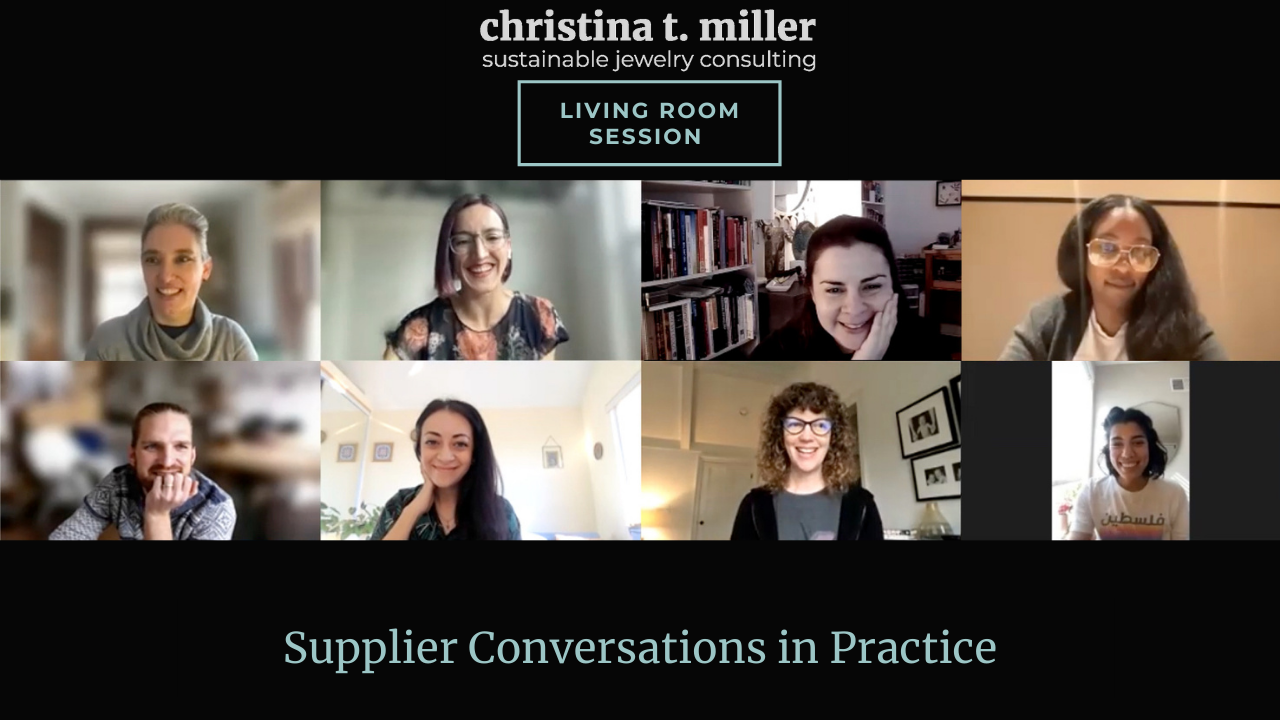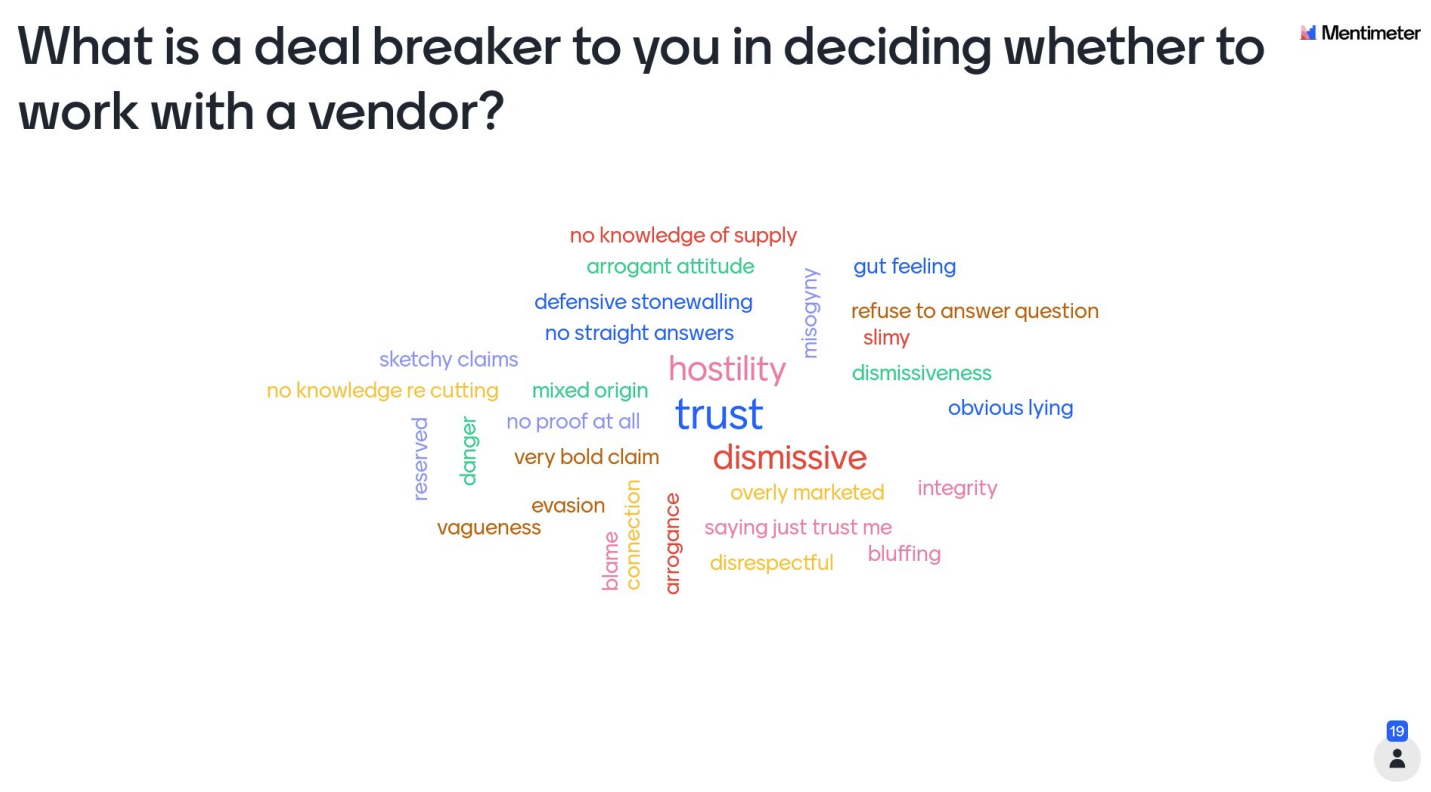
Living Room Session: Supplier Conversations in Practice
Mar 01, 2022Following our January Living Room session, Conversations Worth Having with Cheri Torres, we wanted to see how the techniques and tips we had learned to improve our conversations with jewelry suppliers translated in the real world. The Tucson gem shows were a great opportunity for jewelers and vendors alike to practice Conversations Worth Having techniques. We welcomed jewelers Ashley Thorne, Jalnar Dhanani-Wade, Zulaikha Aziz, and Will Nevins-Alderfer; and suppliers Monica Stephenson and Stuart Pool, to share their experiences and get the conversation rolling.
Amongst our Living Room audience, as well as the panel of guests, the Ethical Gem Fair stood out as the favorite experience. Jalnar noted that knowing that the vendors in that show were already open to having conversations about specific sourcing questions made it easier to connect with them on the story behind a gemstone. The environment at some of the other shows proved a little more challenging to navigate. Ashley specifically noted that because she is interested in working with "Salt and Pepper" diamonds (these diamonds are called this because they contain black and white appearing inclusions), she continues to be challenged when seeking answers to her questions. Salt and pepper diamonds are especially lacking in traceability information. On the positive side, however, Ashley felt she was able to connect with a vendor who was as transparent as possible and also seems interested in tackling this issue. Such an interaction could indeed be the start of a great working relationship.
Zulaikha shared with us that in her experience, walking through the shows and speaking with suppliers when in a group of colleagues was often less challenging than doing so alone. It was one way to signal to suppliers that these questions about sourcing didn’t come from a place of mistrust about the authenticity of their gemstones or their motives, but a place of curiosity from not just the jewelers, but their clients as well. Will also echoed that his clients love to hear the stories about where their gold, diamonds and gemstones come from. He found appreciation for the connections he formed with vendors through introductions by colleagues as it made it easier to get to the story part of the conversation, just like it was at the Ethical Gem Fair. These more relational conversations really helped Will understand the values that the vendors he was speaking with apply to their businesses.
In a business relationship, it can be challenging to create more relational conversations rather than just transactional ones. Ashley Thorne shared a great example of a question she asked a vendor to help create a more relational conversation:
“One of the questions I asked a vendor was, ‘What are you most proud of when it comes to transparency with your moonstones?’ And I could tell that asking him that question kind of lit him up [and made him] excited to share something that he felt really proud of and good about in his business. And that's what led me to being able to source a particular moonstone from him, because he was most proud of a particular moonstone because he could trace it back to the mine and had more information.”
She also had a second example of a situation where a supplier was open about the information she was asking for. Even though she decided not to purchase, the vendor’s response increased her trust in this person.
While forming curious questions with a positive frame could definitely be helpful in many situations, Jalnar also pointed out that the emotional engagement required can be exhausting and is often much easier approached as a group. Will added to this that not only is it easier to ask questions and gather information as a group, but that the community can also be really helpful when you’re making your sourcing decisions. In this space, where we appreciate and promote continual improvement because the realities we are dealing with can be so complicated, it can be hard to decide on your own where to draw the line of what is acceptable and what is not. If a vendor doesn’t meet a certain high standard, but is transparent and is making improvements, how do we decide if that is “enough” for us to purchase from them? This is another area where having the community around you to talk through the issues is helpful.
Zulaikha then pointed out:
“Some of the vendors that I had access to who actually came from the communities [where] the stones that they were providing [were from]. Sometimes they didn't have the same language that maybe the vendors at AGTA did, or the ‘correct’ claims to make, but they still knew where their stones were coming from, and they knew the mining communities. So it took more of an effort to dig a little bit deeper but that was really important to me. It’s just something I wanted to point out - that it's not as easy to reach those folks, but it's still possible.”
One important takeaway at this point is that in order to be inclusive of suppliers for whom certifications or certain standards are unattainable or not yet attainable, we do have to put in more of an effort. However, we can and should take advantage of the community that has formed around the Living Room sessions and beyond to do this heavier lifting together.
Jalnar emphasizes this, as well as the unique position that individual jewelers and small companies are in to be able to have a positive impact:
“I think it's actually really important and it's a great opportunity for us as small jewelers to do something that the bigger companies are just not capable of. For example, from Agere Gems, I got a really small batch of traceable emeralds and they're all different sizes and they're different colors, but I'm gonna make some beautiful pieces with them. I know where they came from. I know her, I know her whole story. Bigger companies need like 1000 pieces of calibrated stone, they can't do stuff like this, they just can't. So, while it is harder for us to navigate sometimes, and more time consuming, and [takes] more energy, it is really important for us to establish these relationships with the smaller vendors so we can grow with them.”
Indeed, while working to create change, we have to leverage our purchasing decisions in just such a way, a way that leans on the unique type of impact you can make.
We were also very glad to hear the perspective of a couple of gemstone suppliers: Monica Stephenson of ANZA Gems and Stuart Pool of Nineteen48, both of whom (together with the Tanzania Women Miners Association and NGO Pact) brought the Moyo Gems project to life. Monica shared that she was appreciative of the opportunity to connect with new buyers and share the story of why she does what she does and provide information that would inform buyers what it means to her to be a part of the Ethical Gem Fair. She also hopes that being able to share detailed information about the way ANZA and Moyo gems are mined, how they reach the consumer, and the impact they have along the way is encouraging those jewelers to then ask for that information from other vendors. Stuart echoed this as well, adding that the relaxed environment of the Ethical Gem Fair is a really important aspect of the show, letting buyers know they have the space and opportunity to ask questions and hear stories.
And beyond stories, Monica has her sights set on being able to provide concrete proof of ANZA’s claims, leading by example for what many of us would like to see from all of our suppliers.
“This year, I would really like to be able to verify, in more concrete ways, the claims that we are making, the stories that we are telling. I really want to be able to objectively, quantifiably, be able to give you that information. I think a few of us who've started early with changing our business models, or creating a business model that's a more advantageous, beneficiary kind of business model have the experience…we've been doing this in practice. Now, how do we take it to that next level of being able to actually prove our claims?”
Following our conversation with the jewelers and suppliers who got the session started, we wanted to move the conversation into a place of a larger group discussion around the topic of accountability. We used a group polling tool to gather answers from the larger audience on the question of what is a deal breaker in deciding whether or not you would work with a certain vendor? Here are the results:

Standing together as a community on where we draw a line in the sand and what situations require group accountability is so important. We next wanted to find out what situations would call for collective accountability of some kind, rather than just an individual deciding to not work with a supplier.

Some ideas that came from the further discussion around this question included both a “carrot” and a “stick” approach. This would mean sharing negative experiences with companies that include some of the above behaviors or actions with others, a calling out. Simultaneously, there is a need for more shared information about companies or vendors that are making a positive impact so that they can be shown extra support. This idea led to the question of how to expand the community of the Ethical Gem Fair as well. It does lead us to a challenge that is very real and relevant to all of this work - vetting. If a list (in any “official” capacity) is created, someone takes on the responsibility of verifying claims, which is truly a huge undertaking. Ethical Metalsmiths, as a non-profit organization, has taken the route of instead providing their forum for their members to share any of this information and share their experiences.
So in bringing the conversation to a close, we find ourselves in a place where we see the importance of us sharing our experiences openly with each other. Banding together when one of us needs support when it comes to holding bad actors accountable and taking collective action as a community of individuals, makers, and small business owners is invaluable. As is uplifting and spreading the word about any suppliers we discover who are making a positive impact.
Join Our Community
Stay up-to-date with our latest content, industry news, and more.
Check your Inbox/Junk folder to confirm you want to receive emails from us. Don't worry, your information will not be shared.

